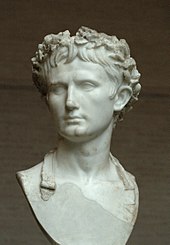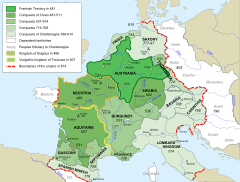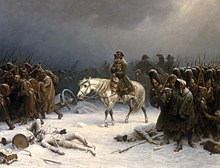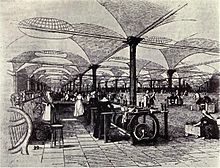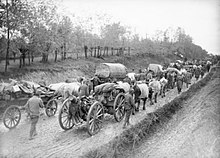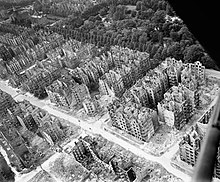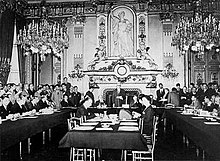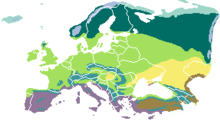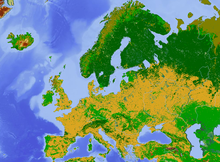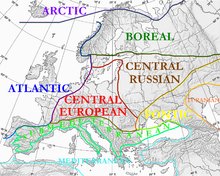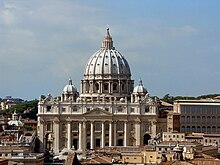Europe
Definition
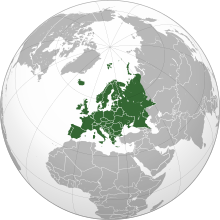 | |
| Area | 10,180,000 km(3,930,000 sq mi) (6th) |
|---|---|
| Population | 741,447,158 (2016; 3rd) |
| Population density | 72.9/km (188/sq mi) (2nd) |
Since around 1850, Europe is most commonly considered as separated from Asia by the watershed divides of the Ural and Caucasus Mountains, the Ural River, the Caspian and Black Seas and the waterways of the Turkish Straits. Though the term "continent" implies physical geography, the land border is somewhat arbitrary and has moved since its first conception in classical antiquity. The division of Eurasia into two continents reflects East-West cultural, linguistic and ethnic differences, some of which vary on a spectrum rather than with a sharp dividing line. The border does not follow political boundaries, with Turkey, Russia and Kazakhstan being transcontinental countries.
Europe covers about 10,180,000 square kilometres (3,930,000 sq mi), or 2% of the Earth's surface (6.8% of land area). Politically, Europe is divided into about fifty sovereign states of which the Russian Federation is the largest and most populous, spanning 39% of the continent and comprising 15% of its population. Europe had a total population of about 741 million (about 11% of the world population) as of 2016. The European climate is largely affected by warm Atlantic currents that temper winters and summers on much of the continent, even at latitudes along which the climate in Asia and North America is severe. Further from the sea, seasonal differences are more noticeable than close to the coast.
Europe, in particular ancient Greece, was the birthplace of Western civilization. The fall of the Western Roman Empire in 476 AD and the subsequent Migration Period marked the end of ancient history and the beginning of the Middle Ages. Renaissance humanism, exploration, art and science led to the modern era. From the Age of Discovery onwards, Europe played a predominant role in global affairs. Between the 16th and 20th centuries, European powers controlled at various times the Americas, almost all of Africa and Oceania and the majority of Asia.
The Age of Enlightenment, the subsequent French Revolution and the Napoleonic Wars shaped the continent culturally, politically and economically from the end of the 17th century till the first half of the 19th century. The Industrial Revolution, which began in Great Britain at the end of the 18th century, gave rise to radical economic, cultural and social change in Western Europe and eventually the wider world. Both world wars took place for the most part in Europe, contributing to a decline in Western European dominance in world affairs by the mid-20th century as the Soviet Union and the United States took prominence. During the Cold War, Europe was divided along the Iron Curtain between NATO in the West and the Warsaw Pact in the East, until the revolutions of 1989 and fall of the Berlin Wall.
In 1949 the Council of Europe was founded, following a speech by Sir Winston Churchill, with the idea of unifying Europe to achieve common goals. It includes all European states except for Belarus, Kazakhstan and Vatican City. Further European integration by some states led to the formation of the European Union (EU), a separate political entity that lies between a confederation and a federation. The EU originated in Western Europe but has been expanding eastward since the fall of the Soviet Union in 1991. The currency of most countries of the European Union, the euro, is the most commonly used among Europeans; and the EU's Schengen Area abolishes border and immigration controls among most of its member states. The European Anthem is "Ode to Joy", and states celebrate peace and unity on Europe Day.
Name
In classical Greek mythology, Europa (Ancient Greek: Εὐρώπη, Eurṓpē) is the name of either a Phoenician princess or of a queen of Crete. The name contains the elements εὐρύς (eurús), "wide, broad" and ὤψ (ōps, gen. ὠπός, ōpós) "eye, face, countenance", hence their composite Eurṓpē would mean "wide-gazing" or "broad of aspect". Broad has been an epithet of Earth herself in the reconstructed Proto-Indo-European religion and the poetry devoted to it. For the second part compare also the divine attributes of "grey-eyed" Athena(γλαυκῶπις, glaukōpis) or ox-eyed Hera (βοῶπις, boōpis).
There have been attempts to connect Eurṓpē to a Semitic term for "west", this being either Akkadian erebu meaning "to go down, set" (said of the sun) or Phoenician 'ereb "evening, west", which is at the origin of Arabic Maghreb and Hebrew ma'arav. Michael A. Barry, professor in Princeton University's Near Eastern Studies Department, finds the mention of the word Ereb on an Assyrian stele with the meaning of "night, [the country of] sunset", in opposition to Asu "[the country of] sunrise", i.e. Asia. The same naming motive according to "cartographic convention" appears in Greek Ἀνατολή (Anatolḗ "[sun] rise", "east", hence Anatolia). Martin Litchfield West stated that "phonologically, the match between Europa's name and any form of the Semitic word is very poor." Next to these hypotheses there is also a Proto-Indo-European root *h1regʷos, meaning "darkness", which also produced Greek Erebus.
Most major world languages use words derived from Eurṓpē or Europa to refer to the continent. Chinese, for example, uses the word Ōuzhōu (歐洲/欧洲); a similar Chinese-derived term Ōshū (欧州) is also sometimes used in Japanese such as in the Japanese name of the European Union, Ōshū Rengō (欧州連合), despite the katakana Yōroppa (ヨーロッパ) being more commonly used. In some Turkic languages the originally Persian name Frangistan ("land of the Franks") is used casually in referring to much of Europe, besides official names such as Avrupa or Evropa.
Definition
Contemporary definition

The prevalent definition of Europe as a geographical term has been in use since the mid-19th century. Europe is taken to be bounded by large bodies of water to the north, west and south; Europe's limits to the far east are usually taken to be the Urals, the Ural River, and the Caspian Sea; to the southeast, including the Caucasus Mountains, the Black Sea and the waterways connecting the Black Sea to the Mediterranean Sea.
Islands are generally grouped with the nearest continental landmass, hence Iceland is generally considered to be part of Europe, while the nearby island of Greenland is usually assigned to North America. Nevertheless, there are some exceptions based on sociopolitical and cultural differences. Cyprus is closest to Anatolia (or Asia Minor), but is usually considered part of Europe both culturally and politically and is a member state of the EU. Malta was considered an island of Northwest Africa for centuries.
"Europe" as used specifically in British English may also refer to Continental Europe exclusively.
History of the concept
Early history
The first recorded usage of Eurṓpē as a geographic term is in the Homeric Hymn to Delian Apollo, in reference to the western shore of the Aegean Sea. As a name for a part of the known world, it is first used in the 6th century BC by Anaximander and Hecataeus. Anaximander placed the boundary between Asia and Europe along the Phasis River (the modern Rioni River) in the Caucasus, a convention still followed by Herodotus in the 5th century BC. Herodotus mentioned that the world had been divided by unknown persons into three parts, Europe, Asia, and Libya (Africa), with the Nile and the Phasis forming their boundaries—though he also states that some considered the River Don, rather than the Phasis, as the boundary between Europe and Asia. Europe's eastern frontier was defined in the 1st century by geographer Strabo at the River Don. The Book of Jubilees described the continents as the lands given by Noah to his three sons; Europe was defined as stretching from the Pillars of Hercules at the Strait of Gibraltar, separating it from Northwest Africa, to the Don, separating it from Asia.
The convention received by the Middle Ages and surviving into modern usage is that of the Roman era used by Roman era authors such as Posidonius, Strabo and Ptolemy, who took the Tanais (the modern Don River) as the boundary.
The term "Europe" is first used for a cultural sphere in the Carolingian Renaissance of the 9th century. From that time, the term designated the sphere of influence of the Western Church, as opposed to both the Eastern Orthodox churches and to the Islamic world.
A cultural definition of Europe as the lands of Latin Christendom coalesced in the 8th century, signifying the new cultural condominium created through the confluence of Germanic traditions and Christian-Latin culture, defined partly in contrast with Byzantium and Islam, and limited to northern Iberia, the British Isles, France, Christianised western Germany, the Alpine regions and northern and central Italy. The concept is one of the lasting legacies of the Carolingian Renaissance: Europaoften figures in the letters of Charlemagne's court scholar, Alcuin.
Modern definitions
The question of defining a precise eastern boundary of Europe arises in the Early Modern period, as the eastern extension of Muscovy began to include Northern Asia.
Throughout the Middle Ages and into the 18th century, the traditional division of the landmass of Eurasia into two continents, Europe and Asia, followed Ptolemy, with the boundary following the Turkish Straits, the Black Sea, the Kerch Strait, the Sea of Azov and the Don (ancient Tanais). But maps produced during the 16th to 18th centuries tended to differ in how to continue the boundary beyond the Don bend at Kalach-na-Donu (where it is closest to the Volga, now joined with it by the Volga–Don Canal), into territory not described in any detail by the ancient geographers.
Philip Johan von Strahlenberg in 1725 was the first to depart from the classical Don boundary by drawing the line along the Volga, following the Volga north until the Samara Bend, along Obshchy Syrt (the drainage divide between Volga and Ural) and then north along Ural Mountains. This was adopted by the Russian Empire, and introduced the convention that would eventually become adopted as standard, but not without criticism by many modern analytical geographers.
The mapmakers continued to differ on the boundary between the lower Don and Samara well into the 19th century. The 1745 atlas published by the Russian Academy of Sciences has the boundary follow the Don beyond Kalach as far as Serafimovich before cutting north towards Arkhangelsk, while other 18th- to 19th-century mapmakers such as John Cary followed Strahlenberg's prescription. To the south, the Kuma–Manych Depression was identified circa 1773 by a German naturalist, Peter Simon Pallas, as a valley that, once upon a time, connected the Black Sea and the Caspian Sea, and subsequently was proposed as a natural boundary between continents.
By the mid-19th century, there were three main conventions, one following the Don, the Volga–Don Canal and the Volga, the other following the Kuma–Manych Depression to the Caspian and then the Ural River, and the third abandoning the Don altogether, following the Greater Caucasus watershed to the Caspian. The question was still treated as a "controversy" in geographical literature of the 1860s, with Douglas Freshfield advocating the Caucasus crest boundary as the "best possible", citing support from various "modern geographers".
In Russia and the Soviet Union, the boundary along the Kuma–Manych Depression was the most commonly used as early as 1906. In 1958, the Soviet Geographical Society formally recommended that the boundary between the Europe and Asia be drawn in textbooks from Baydaratskaya Bay, on the Kara Sea, along the eastern foot of Ural Mountains, then following the Ural River until the Mugodzhar Hills, and then the Emba River; and Kuma–Manych Depression, thus placing the Caucasus entirely in Asia and the Urals entirely in Europe. However, most geographers in the Soviet Union favoured the boundary along the Caucasus crest and this became the standard convention in the later 20th century, although the Kuma–Manych boundary remained in use in some 20th-century maps.
History
Prehistory
Homo erectus georgicus, which lived roughly 1.8 million years ago in Georgia, is the earliest hominid to have been discovered in Europe. Other hominid remains, dating back roughly 1 million years, have been discovered in Atapuerca, Spain. Neanderthal man (named after the Neandertal valley in Germany) appeared in Europe 150,000 years ago and disappeared from the fossil record about 28,000 BC, with their final refuge being present-day Portugal. The Neanderthals were supplanted by modern humans (Cro-Magnons), who appeared in Europe around 43 to 40 thousand years ago.
The European Neolithic period—marked by the cultivation of crops and the raising of livestock, increased numbers of settlements and the widespread use of pottery—began around 7000 BC in Greece and the Balkans, probably influenced by earlier farming practices in Anatolia and the Near East. It spread from the Balkans along the valleys of the Danube and the Rhine (Linear Pottery culture) and along the Mediterranean coast (Cardial culture). Between 4500 and 3000 BC, these central European neolithic cultures developed further to the west and the north, transmitting newly acquired skills in producing copper artefacts. In Western Europe the Neolithic period was characterised not by large agricultural settlements but by field monuments, such as causewayed enclosures, burial mounds and megalithic tombs. The Corded Ware cultural horizon flourished at the transition from the Neolithic to the Chalcolithic. During this period giant megalithic monuments, such as the Megalithic Temples of Malta and Stonehenge, were constructed throughout Western and Southern Europe.
The European Bronze Age began c. 3200 BC in Greece with the Minoan civilization on Crete, the first advanced civilization in Europe.The Minoans were followed by the Myceneans, who collapsed suddenly around 1200 BC, ushering the European Iron Age. Iron Age colonisation by the Greeks and Phoenicians gave rise to early Mediterranean cities. Early Iron Age Italy and Greece from around the 8th century BC gradually gave rise to historical Classical antiquity, whose beginning is sometimes dated to 776 BC, the year the first Olympic Games.
Classical antiquity
Ancient Greece was the founding culture of Western civilisation. Western democratic and rationalist culture are often attributed to Ancient Greece. The Greeks city-state, the polis, was the fundamental political unit of classical Greece. In 508 BC, Cleisthenes instituted the world's first democratic system of government in Athens. The Greek political ideals were rediscovered in the late 18th century by European philosophers and idealists. Greece also generated many cultural contributions: in philosophy, humanism and rationalism under Aristotle, Socrates and Plato; in history with Herodotus and Thucydides; in dramatic and narrative verse, starting with the epic poems of Homer; in drama with Sophocles and Euripides, in medicine with Hippocrates and Galen; and in science with Pythagoras, Euclid and Archimedes. In the course of the 5th century BC, several of the Greek city states would ultimately check the Achaemenid Persian advance in Europe through the Greco-Persian Wars, considered a pivotal moment in world history, as the 50 years of peace that followed are known as Golden Age of Athens, the seminal period of ancient Greece that laid many of the foundations of Western civilization.
Greece was followed by Rome, which left its mark on law, politics, language, engineering, architecture, government and many more key aspects in western civilisation. Expanding from their base in Italy beginning in the 3rd century BC, the Romans gradually expanded to eventually rule the entire Mediterranean basin and western Europe by the turn of the millennium. The Roman Republic ended in 27 BC, when Augustus proclaimed the Roman Empire. The two centuries that followed are known as the pax romana, a period of unprecedented peace, prosperity, and political stability in most of Europe.
The empire continued to expand under emperors such as Antoninus Pius and Marcus Aurelius, who spent time on the Empire's northern border fighting Germanic, Pictish and Scottish tribes. The Empire began to decline in the 3rd century, particularly in the west. Christianity was legalised by Constantine I in 313 AD after three centuries of imperial persecution. Constantine also permanently moved the capital of the empire from Rome to the city of Byzantium, which was renamed Constantinople in his honour (modern-day Istanbul) in 330 AD. Christianity became the sole official religion of the empire in 380 AD, and in 391-392 AD, the emperor Theodosius outlawed pagan religions. This is sometimes considered to mark the end of antiquity; alternatively antiquity is considered to end with the fall of the Western Roman Empire in 476 AD; the closure of the pagan Platonic Academy of Athens in 529 AD; or the rise of Islam in the early 7th century AD.
Early Middle Ages
During the decline of the Roman Empire, Europe entered a long period of change arising from what historians call the "Age of Migrations". There were numerous invasions and migrations amongst the Ostrogoths, Visigoths, Goths, Vandals, Huns, Franks, Angles, Saxons, Slavs, Avars, Bulgars and, later on, the Vikings, Pechenegs, Cumans and Magyars. Renaissance thinkers such as Petrarch would later refer to this as the "Dark Ages". Isolated monastic communities were the only places to safeguard and compile written knowledge accumulated previously; apart from this very few written records survive and much literature, philosophy, mathematics, and other thinking from the classical period disappeared from Western Europe though they were preserved in the east, in the Byzantine Empire.
While the Roman empire in the west continued to decline, Roman traditions and the Roman state remained strong in the predominantly Greek-speaking Eastern Roman Empire, also known as the Byzantine Empire. During most of its existence, the Byzantine Empire was the most powerful economic, cultural, and military force in Europe. Emperor Justinian I presided over Constantinople's first golden age: he established a legal code that forms the basis of many modern legal systems, funded the construction of the Hagia Sophia, and brought the Christian church under state control.
From the 7th century onwards, as the Byzantines and neighbouring Sasanid Persians were severely weakened due the protracted, centuries-lasting and frequent Byzantine–Sasanian wars, the Muslim Arabs began to make inroads into historically Roman territory, taking the Levant and North Africa and making inroads into Asia Minor. In the mid 7th century AD, following the Muslim conquest of Persia, Islam penetrated into the Caucasus region. Over the next centuries Muslim forces took Cyprus, Malta, Crete, Sicily and parts of southern Italy. Between 711 and 720, most of the Iberian Peninsula was brought under Muslim rule — save for small areas in the northwest (Asturias) and largely Basque regions in the Pyrenees. This territory, under the Arabic name Al-Andalus, became part of the expanding Umayyad Caliphate. The unsuccessful second siege of Constantinople (717) weakened the Umayyad dynasty and reduced their prestige. The Umayyads were then defeated by the Frankish leader Charles Martel at the Battle of Poitiers in 732, which ended their northward advance.
During the Dark Ages, the Western Roman Empire fell under the control of various tribes. The Germanic and Slav tribes established their domains over Western and Eastern Europe respectively. Eventually the Frankish tribes were united under Clovis I.Charlemagne, a Frankish king of the Carolingian dynasty who had conquered most of Western Europe, was anointed "Holy Roman Emperor" by the Pope in 800. This led in 962 to the founding of the Holy Roman Empire, which eventually became centred in the German principalities of central Europe.
East Central Europe saw the creation of the first Slavic states and the adoption of Christianity (circa 1000 AD). The powerful West Slavic state of Great Moravia spread its territory all the way south to the Balkans, reaching its largest territorial extent under Svatopluk Iand causing a series of armed conflicts with East Francia. Further south, the first South Slavic states emerged in the late 7th and 8th century and adopted Christianity: the First Bulgarian Empire, the Serbian Principality (later Kingdom and Empire), and the Duchy of Croatia (later Kingdom of Croatia). To the East, the Kievan Rus expanded from its capital in Kiev to become the largest state in Europe by the 10th century. In 988, Vladimir the Great adopted Orthodox Christianity as the religion of state. Further East, Volga Bulgaria became an Islamic state in the 10th century, but was eventually absorbed into Russia several centuries later.
High and Late Middle Ages
The period between the year 1000 and 1300 is known as the High Middle Ages, during which the population of Europe experienced significant growth, culminating in the Renaissance of the 12th century. Economic growth, together with the lack of safety on the mainland trading routes, made possible the development of major commercial routes along the coast of the Mediterranean and Baltic Seas. The growing wealth and independence acquired by some coastal cities gave the Maritime Republics a leading role in the European scene.
The Middle Ages on the mainland were dominated by the two upper echelons of the social structure: the nobility and the clergy. Feudalism developed in France in the Early Middle Ages and soon spread throughout Europe. A struggle for influence between the nobility and the monarchy in England led to the writing of the Magna Carta and the establishment of a parliament. The primary source of culture in this period came from the Roman Catholic Church. Through monasteries and cathedral schools, the Church was responsible for education in much of Europe.
The Papacy reached the height of its power during the High Middle Ages. An East-West Schism in 1054 split the former Roman Empire religiously, with the Eastern Orthodox Church in the Byzantine Empire and the Roman Catholic Church in the former Western Roman Empire. In 1095 Pope Urban II called for a crusade against Muslims occupying Jerusalem and the Holy Land. In Europe itself, the Church organised the Inquisition against heretics. In Spain, the Reconquista concluded with the fall of Granada in 1492, ending over seven centuries of Islamic rule in the Iberian Peninsula.
In the east a resurgent Byzantine Empire recaptured Crete and Cyprus from the Muslims and reconquered the Balkans. Constantinople was the largest and wealthiest city in Europe from the 9th to the 12th centuries, with a population of approximately 400,000. The Empire was weakened following the defeat at Manzikert and was weakened considerably by the sack of Constantinople in 1204, during the Fourth Crusade. Although it would recover Constantinople in 1261, Byzantiumfell in 1453 when Constantinople was taken by the Ottoman Empire.
In the 11th and 12th centuries, constant incursions by nomadic Turkic tribes, such as the Pechenegs and the Cuman-Kipchaks, caused a massive migration of Slavic populations to the safer, heavily forested regions of the north and temporarily halted the expansion of the Rus' state to the south and east. Like many other parts of Eurasia, these territories were overrun by the Mongols. The invaders, who became known as Tatars, were mostly Turkic-speaking peoples under Mongol suzerainty. They established the state of the Golden Horde with headquarters in Crimea, which later adopted Islam as a religion and ruled over modern-day southern and central Russia for more than three centuries. After the collapse of Mongol dominions, the first Romanian states (principalities) emerged in the 14th century: Moldova and Walachia. Previously, these territories were under the successive control of Pechenegs and Cumans. From the 12th to the 15th centuries, the Grand Duchy of Moscow grew from a small principality under Mongol rule to the largest state in Europe, overthrowing the Mongols in 1480 and eventually becoming the Tsardom of Russia. The state was consolidated under Ivan III the Great and Ivan the Terrible, steadily expanding to the east and south over the next centuries.
The Great Famine of 1315–1317 was the first crisis that would strike Europe in the late Middle Ages. The period between 1348 and 1420 witnessed the heaviest loss. The population of France was reduced by half. Medieval Britain was afflicted by 95 famines, and France suffered the effects of 75 or more in the same period. Europe was devastated in the mid-14th century by the Black Death, one of the most deadly pandemics in human history which killed an estimated 25 million people in Europe alone—a third of the European population at the time.
The plague had a devastating effect on Europe's social structure; it induced people to live for the moment as illustrated by Giovanni Boccaccio in The Decameron (1353). It was a serious blow to the Roman Catholic Church and led to increased persecution of Jews, beggars, and lepers. The plague is thought to have returned every generation with varying virulence and mortalities until the 18th century. During this period, more than 100 plague epidemics swept across Europe.
Early modern period
The Renaissance was a period of cultural change originating in Florence and later spreading to the rest of Europe. The rise of a new humanism was accompanied by the recovery of forgotten classical Greek and Arabic knowledge from monastic libraries, often translated from Arabic into Latin. The Renaissance spread across Europe between the 14th and 16th centuries: it saw the flowering of art, philosophy, music, and the sciences, under the joint patronage of royalty, the nobility, the Roman Catholic Church, and an emerging merchant class. Patrons in Italy, including the Medici family of Florentine bankers and the Popes in Rome, funded prolific quattrocento and cinquecento artists such as Raphael, Michelangelo, and Leonardo da Vinci.
Political intrigue within the Church in the mid-14th century caused the Western Schism. During this forty-year period, two popes—one in Avignon and one in Rome—claimed rulership over the Church. Although the schism was eventually healed in 1417, the papacy's spiritual authority had suffered greatly.
The Church's power was further weakened by the Protestant Reformation (1517–1648), initially sparked by the works of German theologian Martin Luther, an attempt to start a reform within the Church. The Reformation also damaged the Holy Roman Emperor's influence, as German princes became divided between Protestant and Roman Catholic faiths. This eventually led to the Thirty Years War (1618–1648), which crippled the Holy Roman Empire and devastated much of Germany, killing between 25 and 40 percent of its population. In the aftermath of the Peace of Westphalia, France rose to predominance within Europe.
The 17th century in southern, central and eastern Europe was a period of general decline. Central and Eastern Europe experienced more than 150 famines in a 200-year period between 1501 and 1700. From the Union of Krewo (1385) central and eastern Europe was dominated by Kingdom of Poland and Grand Duchy of Lithuania. Between 1648 and 1655 in the central and eastern Europe ended hegemony of the Polish–Lithuanian Commonwealth. From the 15th to 18th centuries, when the disintegrating khanates of the Golden Horde were conquered by Russia, Tatars from the Crimean Khanate frequently raided Eastern Slavic lands to capture slaves. Further east, the Nogai Horde and Kazakh Khanate frequently raided the Slavic-speaking areas of Russia, Ukraine and Poland for hundreds of years, until the Russian expansion and conquest of most of northern Eurasia (i.e. Eastern Europe, Central Asia and Siberia). Meanwhile, in the south, the Ottomans had conquered the Balkans by the 15th century, laying siege to Vienna in 1529. In the Battle of Lepanto in 1571, the Holy League checked Ottoman power in the Mediterranean. The Ottomans again laid siege to Vienna in 1683, but the Battle of Vienna permanently ended their advance into Europe, and marked the political hegemony of the Habsburg dynasty in central Europe.
The Renaissance and the New Monarchs marked the start of an Age of Discovery, a period of exploration, invention, and scientific development. Among the great figures of the Western scientific revolution of the 16th and 17th centuries were Copernicus, Kepler, Galileo, and Isaac Newton. According to Peter Barrett, "It is widely accepted that 'modern science' arose in the Europe of the 17th century (towards the end of the Renaissance), introducing a new understanding of the natural world."
In the 15th century, Europe started to extend itself beyond its geographic frontiers. Portugal and Spain, the greatest naval powers of the time, took the lead in exploring the world. A Spanish expedition led by Christopher Columbus reached the New World in 1492, the Portuguese sailor Vasco da Gama opened the ocean route to the East in 1498 and the Spanish explorer Sebastian Elcano made the first circumnavigation of the globe in 1519–1522, and soon after the Spanish and Portuguese began establishing huge global empires in the Americas, Asia, Africa and Oceania.France, the Netherlands and England soon followed in building large colonial empires with vast holdings in Africa, the Americas, and Asia.
18th and 19th centuries
The Age of Enlightenment was a powerful intellectual movement during the 18th century promoting scientific and reason-based thoughts. Discontent with the aristocracy and clergy's monopoly on political power in France resulted in the French Revolution and the establishment of the First Republic as a result of which the monarchy and many of the nobility perished during the initial reign of terror. Napoleon Bonaparte rose to power in the aftermath of the French Revolution and established the First French Empire that, during the Napoleonic Wars, grew to encompass large parts of Europe before collapsing in 1815 with the Battle of Waterloo. Napoleonic rule resulted in the further dissemination of the ideals of the French Revolution, including that of the nation-state, as well as the widespread adoption of the French models of administration, law, and education. The Congress of Vienna, convened after Napoleon's downfall, established a new balance of power in Europe centred on the five "Great Powers": the UK, France, Prussia, Austria, and Russia. This balance would remain in place until the Revolutions of 1848, during which liberal uprisings affected all of Europe except for Russia and the UK. These revolutions were eventually put down by conservative elements and few reforms resulted. The year 1859 saw the unification of Romania, as a nation-state, from smaller principalities. In 1867, the Austro-Hungarian empire was formed; and 1871 saw the unifications of both Italy and Germany as nation-states from smaller principalities.
In parallel, the Eastern Question grew more complex ever since the Ottoman defeat in the Russo-Turkish War (1768–1774). As the dissolution of the Ottoman Empire seemed imminent, the Great Powers struggled to safeguard their strategic and commercial interests in the Ottoman domains. The Russian Empire stood to benefit from the decline, whereas the Habsburg Empire and Britain perceived the preservation of the Ottoman Empire to be in their best interests. Meanwhile, the Serbian revolution(1804) and Greek War of Independence (1821) marked the beginning of the end of Ottoman rule in the Balkans, which ended with the Balkan Wars in 1912-1913. Formal recognition of the de factoindependent principalities of Montenegro, Serbia and Romania ensued at the Congress of Berlin in 1878.
The Industrial Revolution started in Great Britain in the last part of the 18th century and spread throughout Europe. The invention and implementation of new technologies resulted in rapid urban growth, mass employment, and the rise of a new working class. Reforms in social and economic spheres followed, including the first laws on child labour, the legalisation of trade unions, and the abolition of slavery. In Britain, the Public Health Act of 1875 was passed, which significantly improved living conditions in many British cities. Europe's population increased from about 100 million in 1700 to 400 million by 1900. The last major famine recorded in Western Europe, the Irish Potato Famine, caused death and mass emigration of millions of Irish people. In the 19th century, 70 million people left Europe in migrations to various European colonies abroad and to the United States. Demographic growth meant that, by 1900, Europe's share of the world's population was 25%.
20th century to the present
Two world wars and an economic depression dominated the first half of the 20th century. World War I was fought between 1914 and 1918. It started when Archduke Franz Ferdinand of Austria was assassinated by the Yugoslav nationalist Gavrilo Princip. Most European nations were drawn into the war, which was fought between the Entente Powers (France, Belgium, Serbia, Portugal, Russia, the United Kingdom, and later Italy, Greece, Romania, and the United States) and the Central Powers (Austria-Hungary, Germany, Bulgaria, and the Ottoman Empire). The war left more than 16 million civilians and military dead. Over 60 million European soldiers were mobilised from 1914 to 1918.
Russia was plunged into the Russian Revolution, which threw down the Tsarist monarchy and replaced it with the communistSoviet Union. Austria-Hungary and the Ottoman Empire collapsed and broke up into separate nations, and many other nations had their borders redrawn. The Treaty of Versailles, which officially ended World War I in 1919, was harsh towards Germany, upon whom it placed full responsibility for the war and imposed heavy sanctions.
Excess deaths in Russia over the course of World War I and the Russian Civil War (including the postwar famine) amounted to a combined total of 18 million. In 1932–1933, under Stalin's leadership, confiscations of grain by the Soviet authorities contributed to the second Soviet famine which caused millions of deaths; surviving kulaks were persecuted and many sent to Gulags to do forced labour. Stalin was also responsible for the Great Purge of 1937–38 in which the NKVD executed 681,692 people; millions of people were deported and exiled to remote areas of the Soviet Union.
The social revolutions sweeping through Russia also affected other European nations following The Great War: in 1919, with the Weimar Republic in Germany, and the First Austrian Republic; in 1922, with Mussolini's one party fascist government in the Kingdom of Italy, and in Ataturk's Turkish Republic, adopting the Western alphabet, and state secularism. Economic instability, caused in part by debts incurred in the First World War and 'loans' to Germany played havoc in Europe in the late 1920s and 1930s. This and the Wall Street Crash of 1929 brought about the worldwide Great Depression. Helped by the economic crisis, social instability and the threat of communism, fascist movements developed throughout Europe placing Adolf Hitler in power of what became Nazi Germany.
In 1933, Hitler became the leader of Germany and began to work towards his goal of building Greater Germany. Germany re-expanded and took back the Saarland and Rhineland in 1935 and 1936. In 1938, Austria became a part of Germany following the Anschluss. Later that year, following the Munich Agreement signed by Germany, France, the United Kingdom and Italy, Germany annexed the Sudetenland, which was a part of Czechoslovakia inhabited by ethnic Germans, and in early 1939, the remainder of Czechoslovakia was split into the Protectorate of Bohemia and Moravia, controlled by Germany, and the Slovak Republic. At the time, Britain and France preferred a policy of appeasement.
With tensions mounting between Germany and Poland over the future of Danzig, the Germans turned to the Soviets, and signed the Molotov–Ribbentrop Pact, which allowed the Soviets to invade the Baltic states and parts of Poland and Romania. Germany invaded Poland on 1 September 1939, prompting France and the United Kingdom to declare war on Germany on 3 September, opening the European Theatre of World War II. The Soviet invasion of Poland started on 17 September and Poland fell soon thereafter. On 24 September, the Soviet Union attacked the Baltic countries and later, Finland. The British hoped to land at Narvik and send troops to aid Finland, but their primary objective in the landing was to encircle Germany and cut the Germans off from Scandinavian resources. Around the same time, Germany moved troops into Denmark. The Phoney War continued.
In May 1940, Germany attacked France through the Low Countries. France capitulated in June 1940. By August Germany began a bombing offensive on Britain, but failed to convince the Britons to give up. In 1941, Germany invaded the Soviet Union in the Operation Barbarossa. On 7 December 1941 Japan's attack on Pearl Harbor drew the United States into the conflict as allies of the British Empire and other allied forces.
After the staggering Battle of Stalingrad in 1943, the German offensive in the Soviet Union turned into a continual fallback. The Battle of Kursk, which involved the largest tank battle in history, was the last major German offensive on the Eastern Front. In June 1944, British and American forces invaded France in the D-Day landings, opening a new front against Germany. Berlin finally fell in 1945, ending World War II in Europe. The war was the largest and most destructive in human history, with 60 million dead across the world. More than 40 million people in Europe had died as a result of World War II, including between 11 and 17 million people who perished during the Holocaust. The Soviet Union lost around 27 million people (mostly civilians) during the war, about half of all World War II casualties. By the end of World War II, Europe had more than 40 million refugees. Several post-war expulsions in Central and Eastern Europe displaced a total of about 20 million people.
World War I and especially World War II diminished the eminence of Western Europe in world affairs. After World War II the map of Europe was redrawn at the Yalta Conference and divided into two blocs, the Western countries and the communist Eastern bloc, separated by what was later called by Winston Churchill an "Iron Curtain". The United States and Western Europe established the NATO alliance and later the Soviet Union and Central Europe established the Warsaw Pact.
The two new superpowers, the United States and the Soviet Union, became locked in a fifty-year-long Cold War, centred on nuclear proliferation. At the same time decolonisation, which had already started after World War I, gradually resulted in the independence of most of the European colonies in Asia and Africa. In the 1980s the reforms of Mikhail Gorbachev and the Solidarity movement in Poland accelerated the collapse of the Eastern bloc and the end of the Cold War. Germany was reunited, after the symbolic fall of the Berlin Wall in 1989, and the maps of Central and Eastern Europe were redrawn once more.
European integration also grew after World War II. The Treaty of Rome in 1957 established the European Economic Communitybetween six Western European states with the goal of a unified economic policy and common market. In 1967 the EEC, European Coal and Steel Community and Euratom formed the European Community, which in 1993 became the European Union. The EU established a parliament, court and central bank and introduced the euro as a unified currency. Between 2004 and 2013, more Central and Eastern European countries began joining, expanding the EU to its current size of 28 European countries, and once more making Europe a major economical and political centre of power. However, in June 2016 the people of the United Kingdom, in a non-binding referendum on EU membership voted to leave the European Union.
Geography
Europe makes up the western fifth of the Eurasian landmass. It has a higher ratio of coast to landmass than any other continent or subcontinent. Its maritime borders consist of the Arctic Ocean to the north, the Atlantic Ocean to the west, and the Mediterranean, Black, and Caspian Seas to the south. Land relief in Europe shows great variation within relatively small areas. The southern regions are more mountainous, while moving north the terrain descends from the high Alps, Pyrenees, and Carpathians, through hilly uplands, into broad, low northern plains, which are vast in the east. This extended lowland is known as the Great European Plain, and at its heart lies the North German Plain. An arc of uplands also exists along the north-western seaboard, which begins in the western parts of the islands of Britain and Ireland, and then continues along the mountainous, fjord-cut spine of Norway.
This description is simplified. Sub-regions such as the Iberian Peninsula and the Italian Peninsula contain their own complex features, as does mainland Central Europe itself, where the relief contains many plateaus, river valleys and basins that complicate the general trend. Sub-regions like Iceland, Britain, and Ireland are special cases. The former is a land unto itself in the northern ocean which is counted as part of Europe, while the latter are upland areas that were once joined to the mainland until rising sea levels cut them off.
Climate
Europe lies mainly in the temperate climate zones, being subjected to prevailing westerlies. The climate is milder in comparison to other areas of the same latitude around the globe due to the influence of the Gulf Stream. The Gulf Stream is nicknamed "Europe's central heating", because it makes Europe's climate warmer and wetter than it would otherwise be. The Gulf Stream not only carries warm water to Europe's coast but also warms up the prevailing westerly winds that blow across the continent from the Atlantic Ocean.
Therefore, the average temperature throughout the year of Naples is 16 °C (61 °F), while it is only 12 °C (54 °F) in New York City which is almost on the same latitude. Berlin, Germany; Calgary, Canada; and Irkutsk, in the Asian part of Russia, lie on around the same latitude; January temperatures in Berlin average around 8 °C (14 °F) higher than those in Calgary, and they are almost 22 °C (40 °F) higher than average temperatures in Irkutsk. Similarly, northern parts of Scotland have a temperate marine climate. The yearly average temperature in city of Inverness is 9.05 °C (48.29 °F). However, Churchill, Manitoba, Canada, is on roughly the same latitude and has an average temperature of −6.5 °C (20.3 °F), giving it a nearly subarctic climate.
Geology
The geological history of Europe traces back to the formation of the Baltic Shield (Fennoscandia) and the Sarmatian craton, both around 2.25 billion years ago, followed by the Volgo–Uralia shield, the three together leading to the East European craton (≈ Baltica) which became a part of the supercontinent Columbia. Around 1.1 billion years ago, Baltica and Arctica (as part of the Laurentia block) became joined to Rodinia, later resplitting around 550 million years ago to reform as Baltica. Around 440 million years ago Euramerica was formed from Baltica and Laurentia; a further joining with Gondwana then leading to the formation of Pangea. Around 190 million years ago, Gondwana and Laurasia split apart due to the widening of the Atlantic Ocean. Finally, and very soon afterwards, Laurasia itself split up again, into Laurentia (North America) and the Eurasian continent. The land connection between the two persisted for a considerable time, via Greenland, leading to interchange of animal species. From around 50 million years ago, rising and falling sea levels have determined the actual shape of Europe, and its connections with continents such as Asia. Europe's present shape dates to the late Tertiary period about five million years ago.
The geology of Europe is hugely varied and complex, and gives rise to the wide variety of landscapes found across the continent, from the Scottish Highlands to the rolling plains of Hungary. Europe's most significant feature is the dichotomy between highland and mountainous Southern Europe and a vast, partially underwater, northern plain ranging from Ireland in the west to the Ural Mountains in the east. These two halves are separated by the mountain chains of the Pyrenees and Alps/Carpathians. The northern plains are delimited in the west by the Scandinavian Mountains and the mountainous parts of the British Isles. Major shallow water bodies submerging parts of the northern plains are the Celtic Sea, the North Sea, the Baltic Sea complex and Barents Sea.
The northern plain contains the old geological continent of Baltica, and so may be regarded geologically as the "main continent", while peripheral highlands and mountainous regions in the south and west constitute fragments from various other geological continents. Most of the older geology of western Europe existed as part of the ancient microcontinent Avalonia.
Flora
Having lived side-by-side with agricultural peoples for millennia, Europe's animals and plants have been profoundly affected by the presence and activities of man. With the exception of Fennoscandia and northern Russia, few areas of untouched wilderness are currently found in Europe, except for various national parks.
The main natural vegetation cover in Europe is mixed forest. The conditions for growth are very favourable. In the north, the Gulf Stream and North Atlantic Drift warm the continent. Southern Europe could be described as having a warm, but mild climate. There are frequent summer droughts in this region. Mountain ridges also affect the conditions. Some of these (Alps, Pyrenees) are oriented east-west and allow the wind to carry large masses of water from the ocean in the interior. Others are oriented south-north (Scandinavian Mountains, Dinarides, Carpathians, Apennines) and because the rain falls primarily on the side of mountains that is oriented towards the sea, forests grow well on this side, while on the other side, the conditions are much less favourable. Few corners of mainland Europe have not been grazed by livestock at some point in time, and the cutting down of the pre-agricultural forest habitat caused disruption to the original plant and animal ecosystems.
Probably 80 to 90 percent of Europe was once covered by forest. It stretched from the Mediterranean Sea to the Arctic Ocean. Though over half of Europe's original forests disappeared through the centuries of deforestation, Europe still has over one quarter of its land area as forest, such as the broadleaf and mixed forests, taiga of Scandinavia and Russia, mixed rainforests of the Caucasus and the Cork oak forests in the western Mediterranean. During recent times, deforestation has been slowed and many trees have been planted. However, in many cases monoculture plantations of conifers have replaced the original mixed natural forest, because these grow quicker. The plantations now cover vast areas of land, but offer poorer habitats for many European forest dwelling species which require a mixture of tree species and diverse forest structure. The amount of natural forest in Western Europe is just 2–3% or less, in European Russia 5–10%. The country with the smallest percentage of forested area is Iceland (1%), while the most forested country is Finland (77%).
In temperate Europe, mixed forest with both broadleaf and coniferous trees dominate. The most important species in central and western Europe are beech and oak. In the north, the taiga is a mixed spruce–pine–birch forest; further north within Russia and extreme northern Scandinavia, the taiga gives way to tundra as the Arctic is approached. In the Mediterranean, many olive trees have been planted, which are very well adapted to its arid climate; Mediterranean Cypress is also widely planted in southern Europe. The semi-arid Mediterranean region hosts much scrub forest. A narrow east-west tongue of Eurasian grassland (the steppe) extends eastwards from Ukraine and southern Russia and ends in Hungary and traverses into taiga to the north.
Fauna
Glaciation during the most recent ice age and the presence of man affected the distribution of European fauna. As for the animals, in many parts of Europe most large animals and top predator species have been hunted to extinction. The woolly mammoth was extinct before the end of the Neolithic period. Today wolves (carnivores) and bears (omnivores) are endangered. Once they were found in most parts of Europe. However, deforestation and hunting caused these animals to withdraw further and further. By the Middle Ages the bears' habitats were limited to more or less inaccessible mountains with sufficient forest cover. Today, the brown bear lives primarily in the Balkan peninsula, Scandinavia, and Russia; a small number also persist in other countries across Europe (Austria, Pyrenees etc.), but in these areas brown bear populations are fragmented and marginalised because of the destruction of their habitat. In addition, polar bears may be found on Svalbard, a Norwegian archipelago far north of Scandinavia. The wolf, the second largest predator in Europe after the brown bear, can be found primarily in Central and Eastern Europe and in the Balkans, with a handful of packs in pockets of Western Europe (Scandinavia, Spain, etc.).
European wild cat, foxes (especially the red fox), jackal and different species of martens, hedgehogs, different species of reptiles (like snakes such as vipers and grass snakes) and amphibians, different birds (owls, hawks and other birds of prey).
Important European herbivores are snails, larvae, fish, different birds, and mammals, like rodents, deer and roe deer, boars, and living in the mountains, marmots, steinbocks, chamois among others. A number of insects, such as the small tortoiseshell butterfly, add to the biodiversity.
The extinction of the dwarf hippos and dwarf elephants has been linked to the earliest arrival of humans on the islands of the Mediterranean.
Sea creatures are also an important part of European flora and fauna. The sea flora is mainly phytoplankton. Important animals that live in European seas are zooplankton, molluscs, echinoderms, different crustaceans, squids and octopuses, fish, dolphins, and whales.
Biodiversity is protected in Europe through the Council of Europe's Bern Convention, which has also been signed by the European Community as well as non-European states.
Politics
The political map of Europe is substantially derived from the re-organisation of Europe following the Napoleonic Wars in 1815. The prevalent form of government in Europe is parliamentary democracy, in most cases in the form of Republic; in 1815, the prevalent form of government was still the Monarchy. Europe's remaining eleven monarchies are constitutional.
European integration is the process of political, legal, economic (and in some cases social and cultural) integration of European states as it has been pursued by the powers sponsoring the Council of Europe since the end of World War II The European Union has been the focus of economic integration on the continent since its foundation in 1993. More recently, the Eurasian Economic Union has been established as a counterpart comprising former Soviet states.
28 European states are members of the politico-economic European Union, 26 of the border-free Schengen Area and 19 of the monetary union Eurozone. Among the smaller European organizations are the Nordic Council, the Benelux, the Baltic Assembly and the Visegrád Group.
List of states and territories
The list below includes all entities falling even partially under any of the various common definitions of Europe, geographic or political.
| Flag | Symbol | Name | Area (km) | Population | Population density (per km) | Capital | Name(s) in official language(s) |
|---|---|---|---|---|---|---|---|
| Albania | 28,748 | 2,876,591 | 98.5 | Tirana | Shqipëria | ||
| Andorra | 468 | 77,281 | 179.8 | Andorra la Vella | Andorra | ||
| Armenia | 29,743 | 2,924,816 | 101.5 | Yerevan | Hayastan | ||
| Austria | 83,858 | 8,823,054 | 104 | Vienna | Österreich | ||
| Azerbaijan | 86,600 | 9,911,646 | 113 | Baku | Azǝrbaycan | ||
| Belarus | 207,560 | 9,504,700 | 45.8 | Minsk | Беларусь (Belaruś) | ||
| Belgium | 30,528 | 11,358,357 | 372.06 | Brussels | België/Belgique/Belgien | ||
| Bosnia and Herzegovina | 51,129 | 3,531,159 | 68.97 | Sarajevo | Bosna i Hercegovina/Боснa и Херцеговина | ||
| Bulgaria | 110,910 | 7,101,859 | 64.9 | Sofia | България (Bǎlgariya) | ||
| Croatia | 56,542 | 4,284,889 | 75.8 | Zagreb | Hrvatska | ||
| Cyprus | 9,251 | 1,170,125 | 123.4 | Nicosia | Kýpros/Kıbrıs | ||
| Czech Republic | 78,866 | 10,610,947 | 134 | Prague | Česko | ||
| Denmark | 43,094 | 5,748,796 | 133.9 | Copenhagen | Danmark | ||
| Estonia | 45,226 | 1,319,133 | 28 | Tallinn | Eesti | ||
| Finland | 336,593 | 5,509,717 | 16 | Helsinki | Suomi/Finland | ||
| France | 547,030 | 67,186,638 | 116 | Paris | France | ||
| Georgia | 69,700 | 3,718,200 | 53.5 | Tbilisi | Sakartvelo | ||
| Germany | 357,168 | 82,800,000 | 232 | Berlin | Deutschland | ||
| Greece | 131,957 | 10,768,477 | 82 | Athens | Ελλάδα (Elláda) | ||
| Hungary | 93,030 | 9,797,561 | 105.3 | Budapest | Magyarország | ||
| Iceland | 103,000 | 350,710 | 3.2 | Reykjavík | Ísland | ||
| Ireland | 70,280 | 4,761,865 | 67.7 | Dublin | Éire/Ireland | ||
| Italy | 301,338 | 60,589,445 | 201.3 | Rome | Italia | ||
| Kazakhstan | 2,724,900 | 17,987,736 | 6.49 | Astana | Қазақстан (Qazaqstan) | ||
| Latvia | 64,589 | 1,953,200 | 34.3 | Riga | Latvija | ||
| Liechtenstein | 160 | 38,111 | 227 | Vaduz | Liechtenstein | ||
| Lithuania | 65,300 | 2,988,400 | 45.8 | Vilnius | Lietuva | ||
| Luxembourg | 2,586 | 602,005 | 233.7 | Luxembourg | Lëtzebuerg/Luxemburg/Luxembourg | ||
| Macedonia | 25,713 | 2,103,721 | 80.1 | Skopje | Македонија (Makedonija) | ||
| Malta | 316 | 445,426 | 1,410 | Valletta | Malta | ||
| Moldova | 33,846 | 4,434,547 | 131.0 | Chișinău | Moldova | ||
| Monaco | 2.020 | 38,400 | 18,713 | Monaco | Monaco | ||
| Montenegro | 13,812 | 642,550 | 45.0 | Podgorica | Crna Gora/Црна Гора | ||
| Netherlands | 41,543 | 17,200,671 | 414.9 | Amsterdam | Nederland | ||
| Norway | 385,203 | 5,295,619 | 15.8 | Oslo | Norge/Noreg/Norga | ||
| Poland | 312,685 | 38,422,346 | 123.5 | Warsaw | Polska | ||
| Portugal | 92,212 | 10,379,537 | 115 | Lisbon | Portugal | ||
| Romania | 238,397 | 19,638,000 | 84.4 | Bucharest | România | ||
| Russia | 17,098,246 | 144,526,636 | 8.4 | Moscow | Россия (Rossiya) | ||
| San Marino | 61.2 | 33,285 | 520 | San Marino | San Marino | ||
| Serbia | 88,361 | 7,040,272 | 91.1 | Belgrade | Srbija/Србија | ||
| Slovakia | 49,035 | 5,435,343 | 111.0 | Bratislava | Slovensko | ||
| Slovenia | 20,273 | 2,066,880 | 101.8 | Ljubljana | Slovenija | ||
| Spain | 505,990 | 46,698,151 | 92 | Madrid | España | ||
| Sweden | 450,295 | 10,151,588 | 22.5 | Stockholm | Sverige | ||
| Switzerland | 41,285 | 8,401,120 | 202 | Bern | Schweiz/Suisse/Svizzera/Svizra | ||
| Turkey | 783,356 | 80,810,525 | 105 | Ankara | Türkiye | ||
| Ukraine | 603,628 | 42,418,235 | 73.8 | Kiev | Україна (Ukraina) | ||
| United Kingdom | 244,820 | 65,648,100 | 270.7 | London | United Kingdom | ||
| Vatican City | 0.44 | 1000 | 2,272 | Vatican City | Città del Vaticano/Civitas Vaticana | ||
| Total | 50 | 10,180,000 | 742,000,000 | 73 | |||
Within the above-mentioned states are several de facto independent countries with limited to no international recognition. None of them are members of the UN:
| Flag | Symbol | Name | Area (km²) | Population | Population density (per km²) | Capital |
|---|---|---|---|---|---|---|
| Abkhazia | 8,660 | 243,206 | 28 | Sukhumi | ||
| Artsakh | 11,458 | 150,932 | 12 | Stepanakert | ||
| Kosovo | 10,908 | 1,920,079 | 159 | Pristina | ||
| Northern Cyprus | 3,355 | 313,626 | 93 | Nicosia | ||
| South Ossetia | 3,900 | 53,532 | 13.7 | Tskhinvali | ||
| Transnistria | 4,163 | 475,665 | 114 | Tiraspol |
Several dependencies and similar territories with broad autonomy are also found within or in close proximity to Europe. This includes Åland (a region of Finland), two constituent countries of the Kingdom Denmark (other than Denmark itself), three Crown dependencies, and two British Overseas Territories. Svalbard is also included due to its unique status within Norway, although it is not autonomous. Not included are the three countries of the United Kingdom with devolved powers and the two Autonomous Regions of Portugal, which despite having a unique degree of autonomy, are not largely self-governing in matters other than international affairs. Areas with little more than a unique tax status, such as Heligoland and the Canary Islands, are also not included for this reason.
| Flag | Symbol | Name | Area (km²) | Population | Population density (per km²) | Capital |
|---|---|---|---|---|---|---|
| Sovereign Base Areas of Akrotiri and Dhekelia (UK) | 254 | 15,700 | 59.1 | Episkopi Cantonment | ||
| Åland (Finland) | 13,517 | 29,489 | 18.36 | Mariehamn | ||
| Bailiwick of Guernsey (UK) | 78 | 65,849 | 844.0 | St. Peter Port | ||
| Bailiwick of Jersey (UK) | 118.2 | 100,080 | 819 | Saint Helier | ||
| Faroe Islands (Denmark) | 1,399 | 50,778 | 35.2 | Tórshavn | ||
| Gibraltar (UK) | 6.7 | 32,194 | 4,328 | Gibraltar | ||
| Greenland (Denmark) | 2,166,086 | 55,877 | 0.0028 | Nuuk | ||
| Isle of Man (UK) | 572 | 83,314 | 148 | Douglas | ||
| Svalbard (Norway) | 61,022 | 2,667 | 0.044 | Longyearbyen |
Economy
As a continent, the economy of Europe is currently the largest on Earth and it is the richest region as measured by assets under management with over $32.7 trillion compared to North America's $27.1 trillion in 2008. In 2009 Europe remained the wealthiest region. Its $37.1 trillion in assets under management represented one-third of the world's wealth. It was one of several regions where wealth surpassed its precrisis year-end peak. As with other continents, Europe has a large variation of wealth among its countries. The richer states tend to be in the West; some of the Central and Eastern European economies are still emerging from the collapse of the Soviet Union and the breakup of Yugoslavia.
The European Union, a political entity composed of 28 European states, comprises the largest single economic area in the world. 19 EU countries share the euro as a common currency. Five European countries rank in the top ten of the world's largest national economies in GDP (PPP). This includes (ranks according to the CIA): Germany (5), the UK (6), Russia (7), France (8), and Italy (10).
There is huge disparity between many European countries in terms of their income. The richest in terms of GDP per capita is Monaco with its US$172,676 per capita (2009) and the poorest is Moldova with its GDP per capita of US$1,631 (2010). Monaco is the richest country in terms of GDP per capita in the world according to the World Bank report.
As a whole, Europe's GDP per capita is US$21,767 according to a 2016 International Monetary Fund assessment.
| Rank | Country | GDP (nominal, Peak Year) millions of USD | Peak Year |
|---|---|---|---|
| European Union | 19,669,743 | 2018 | |
| 1 | Germany | 4,211,635 | 2018 |
| 2 | United Kingdom | 3,075,538 | 2007 |
| 3 | France | 2,937,321 | 2008 |
| 4 | Italy | 2,402,062 | 2008 |
| 5 | Russia | 2,297,125 | 2013 |
| 6 | Spain | 1,642,765 | 2008 |
| 7 | Turkey | 950,328 | 2013 |
| 8 | Netherlands | 945,327 | 2018 |
| 9 | Switzerland | 741,688 | 2018 |
| 10 | Poland | 614,190 | 2018 |
| Rank | Country | GDP (PPP, Peak Year) millions of USD | Peak Year |
|---|---|---|---|
| European Union | 21,998,468 | 2018 | |
| 1 | Germany | 4,373,951 | 2018 |
| 2 | Russia | 4,168,884 | 2018 |
| 3 | United Kingdom | 3,028,566 | 2018 |
| 4 | France | 2,960,251 | 2018 |
| 5 | Italy | 2,399,825 | 2018 |
| 6 | Turkey | 2,320,641 | 2018 |
| 7 | Spain | 1,864,105 | 2018 |
| 8 | Poland | 1,193,112 | 2018 |
| 9 | Netherlands | 966,742 | 2018 |
| 10 | Belgium | 550,664 | 2018 |
Economic history
- Industrial growth (1760–1945)
Capitalism has been dominant in the Western world since the end of feudalism. From Britain, it gradually spread throughout Europe. The Industrial Revolution started in Europe, specifically the United Kingdom in the late 18th century, and the 19th century saw Western Europe industrialise. Economies were disrupted by World War I but by the beginning of World War II they had recovered and were having to compete with the growing economic strength of the United States. World War II, again, damaged much of Europe's industries.
- Cold War (1945–1991)
After World War II the economy of the UK was in a state of ruin, and continued to suffer relative economic decline in the following decades. Italy was also in a poor economic condition but regained a high level of growth by the 1950s. West Germany recovered quickly and had doubled production from pre-war levels by the 1950s. France also staged a remarkable comeback enjoying rapid growth and modernisation; later on Spain, under the leadership of Franco, also recovered, and the nation recorded huge unprecedented economic growth beginning in the 1960s in what is called the Spanish miracle. The majority of Central and Eastern Europeanstates came under the control of the Soviet Union and thus were members of the Council for Mutual Economic Assistance (COMECON).
The states which retained a free-market system were given a large amount of aid by the United States under the Marshall Plan. The western states moved to link their economies together, providing the basis for the EU and increasing cross border trade. This helped them to enjoy rapidly improving economies, while those states in COMECON were struggling in a large part due to the cost of the Cold War. Until 1990, the European Community was expanded from 6 founding members to 12. The emphasis placed on resurrecting the West German economy led to it overtaking the UK as Europe's largest economy.
- Reunification (1991–present)
With the fall of communism in Central and Eastern Europe in 1991, the post-socialist states began free market reforms: Poland, Hungary, and Slovenia adopted them reasonably quickly, while Ukraine and Russia are still in the process of doing so.
After East and West Germany were reunited in 1990, the economy of West Germany struggled as it had to support and largely rebuild the infrastructure of East Germany.
By the millennium change, the EU dominated the economy of Europe comprising the five largest European economies of the time namely Germany, the United Kingdom, France, Italy, and Spain. In 1999, 12 of the 15 members of the EU joined the Eurozone replacing their former national currencies by the common euro. The three who chose to remain outside the Eurozone were: the United Kingdom, Denmark, and Sweden. The European Union is now the largest economy in the world.
Figures released by Eurostat in 2009 confirmed that the Eurozone had gone into recession in 2008. It impacted much of the region. In 2010, fears of a sovereign debt crisis developed concerning some countries in Europe, especially Greece, Ireland, Spain, and Portugal. As a result, measures were taken, especially for Greece, by the leading countries of the Eurozone. The EU-27 unemployment rate was 10.3% in 2012. For those aged 15–24 it was 22.4%.
Demographics
In 2016, the population of Europe was estimated to be 741 million according to the 2017 revision of the World Population Prospects, which is slightly more than one-ninth of the world's population. A century ago, Europe had nearly a quarter of the world's population. The population of Europe has grown in the past century, but in other areas of the world (in particular Africa and Asia) the population has grown far more quickly. Among the continents, Europe has a relatively high population density, second only to Asia. Most of Europe is in a mode of Sub-replacement fertility, which means that each new(-born) generation is being less populous than the older. The most densely populated country in Europe (and in the world) is the microstate of Monaco.
Ethnic groups
Pan and Pfeil (2004) count 87 distinct "peoples of Europe", of which 33 form the majority population in at least one sovereign state, while the remaining 54 constitute ethnic minorities. According to UN population projection, Europe's population may fall to about 7% of world population by 2050, or 653 million people (medium variant, 556 to 777 million in low and high variants, respectively). Within this context, significant disparities exist between regions in relation to fertility rates. The average number of children per female of child bearing age is 1.52. According to some sources, this rate is higher among Muslims in Europe. The UN predicts a steady population decline in Central and Eastern Europe as a result of emigration and low birth rates.
Migration
Europe is home to the highest number of migrants of all global regions at 70.6 million people, the IOM's report said. In 2005, the EU had an overall net gain from immigration of 1.8 million people. This accounted for almost 85% of Europe's total population growth. The European Union plans to open the job centres for legal migrant workers from Africa. In 2008, 696,000 persons were given citizenship of an EU27 member state, a decrease from 707,000 the previous year.
Emigration from Europe began with Spanish and Portuguese settlers in the 16th century, and French and English settlers in the 17th century. But numbers remained relatively small until waves of mass emigration in the 19th century, when millions of poor families left Europe.
Today, large populations of European descent are found on every continent. European ancestry predominates in North America, and to a lesser degree in South America (particularly in Uruguay, Argentina, Chile and Brazil, while most of the other Latin American countries also have a considerable population of European origins). Australia and New Zealand have large European derived populations. Africa has no countries with European-derived majorities (or with the exception of Cape Verde and probably São Tomé and Príncipe, depending on context), but there are significant minorities, such as the White South Africans. In Asia, European-derived populations predominate in Northern Asia (specifically Russians) and some parts of Northern Kazakhstan.
Languages
Europe has about 225 indigenous languages, mostly falling within three Indo-European language groups: the Romance languages, derived from the Latin of the Roman Empire; the Germanic languages, whose ancestor language came from southern Scandinavia; and the Slavic languages. Slavic languages are most spoken by the number of native speakers in Europe, they are spoken in Central, Eastern, and Southeastern Europe. Romance languages are spoken primarily in south-western Europe as well as in Romania and Moldova, in Eastern Europe. Germanic languages are spoken in Northern Europe, the British Isles and some parts of Central Europe. Other Indo-European languages outside the three main groups include the Baltic group (that is, Latvian and Lithuanian), the Celtic group (that is, Irish, Scottish Gaelic, Manx, Welsh, Cornish, and Breton), Greek, Armenian, and Albanian.
Turkic languages include Azerbaijani and Turkish, in addition to smaller languages in Eastern and Southeast Europe (Balkan Gagauz Turkish, Bashkir, Chuvash, Crimean Tatar, Karachay-Balkar, Kumyk, Nogai, and Tatar). A distinct non-Indo-European family of Uralic languages (Estonian, Finnish, Hungarian, Erzya, Komi, Mari, Moksha, and Udmurt) is spoken mainly in Estonia, Finland, Hungary, and parts of Russia, while Kartvelian languages (Georgian, Mingrelian, and Svan) are spoken primarily in Georgia. Two other language families reside in the North Caucasus (termed Northeast Caucasian, most notably including Chechen, Avar, and Lezgin; and Northwest Caucasian, most notably including Adyghe). Maltese is the only Semitic language that is official within the EU, while Basque is the only European language isolate.
Multilingualism and the protection of regional and minority languages are recognised political goals in Europe today. The Council of Europe Framework Convention for the Protection of National Minorities and the Council of Europe's European Charter for Regional or Minority Languages set up a legal framework for language rights in Europe.
Major cities
The four most populous cities of Europe are Istanbul, Moscow, Paris and London, each have over 10 million residents, and as such have been described as megacities. While Istanbul has the highest total population, one third lies on the Asian side of the Bosporus, making Moscow the most populous city entirely in Europe. The next largest cities in order of population are Madrid, Barcelona, Saint Petersburg, Rome, Berlin, Milan and Athens, each having over 3 million residents.
When considering the commuter belts or metropolitan areas, within the EU (for which comparable data is available) London covers the largest population, followed in order by Paris, Madrid, Barcelona, Berlin, the Ruhr area, Rome, Milan, Athens and Warsaw.
Culture
"Europe" as a cultural concept is substantially derived from the shared heritage of the Roman Empire and its culture. The boundaries of Europe were historically understood as those of Christendom (or more specifically Latin Christendom), as established or defended throughout the medieval and early modern history of Europe, especially against Islam, as in the Reconquista and the Ottoman wars in Europe.
This shared cultural heritage is combined by overlapping indigenous national cultures and folklores, roughly divided into Slavic, Latin (Romance) and Germanic, but with several components not part of either of these group (notably Greek and Celtic). Cultural contact and mixtures characterise much of European regional cultures; Kaplan (2014) describes Europe as "embracing maximum cultural diversity at minimal geographical distances".
Religion
 |
| Percentage of popular belief in God per European country according to the Eurobarometer (2005). |
The largest religion in Europe is Christianity, with 76.2% of Europeans considering themselves Christians, including Catholic, Eastern Orthodox and various Protestant denominations. Among Protestants, the most popular are historically state-supported European denominations such as Lutheranism, Anglicanism and the Reformed faith. Other Protestant denominations such as historically significant ones like Anabaptists were never supported by any state and thus are not so widespread, as well as these newly arriving from the United States such as Pentecostalism, Adventism, Methodism, Baptists and various Evangelical Protestants; although Methodism and Baptists both have European origins. The notion of "Europe" and the "Western World" has been intimately connected with the concept of "Christianity and Christendom"; many even attribute Christianity for being the link that created a unified European identity.
Christianity, including the Roman Catholic Church, has played a prominent role in the shaping of Western civilization since at least the 4th century, and for at least a millennium and a half, Europe has been nearly equivalent to Christian culture, even though the religion was inherited from the Middle East. Christian culture was the predominant force in western civilization, guiding the course of philosophy, art, and science.
The second most popular religion is Islam (6%) concentrated mainly in the Balkans and eastern Europe (Bosnia and Herzegovina, Albania, Kosovo, Kazakhstan, North Cyprus, Turkey, Azerbaijan, North Caucasus, and the Volga-Ural region). Other religions, including Judaism, Hinduism, and Buddhism are minority religions (though Tibetan Buddhism is the majority religion of Russia's Republic of Kalmykia). The 20th century saw the revival of Neopaganism through movements such as Wicca and Druidry.
Europe has become a relatively secular continent, with an increasing number and proportion of irreligious, atheist and agnostic people, who make up about 18.2% of Europe's population, actually the largest secular population in the Western world. There are a particularly high number of self-described non-religious people in the Czech Republic, Estonia, Sweden, former East Germany, and France.
Retrieved from: https://en.wikipedia.org/wiki/EuropeText is available under the Creative Commons Attribution-ShareAlike License










